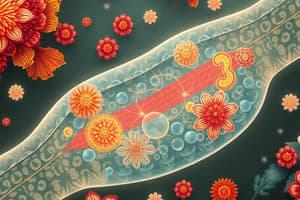Podcast
Questions and Answers
What is the primary function of the cell membrane?
What is the primary function of the cell membrane?
- To provide structural support to the cell
- To control the movement of substances in and out of the cell (correct)
- To facilitate cellular reproduction
- To store genetic information
Which statement best describes the fluid mosaic model of the cell membrane?
Which statement best describes the fluid mosaic model of the cell membrane?
- It maintains a constant, unchanging composition.
- It is composed of a rigid structure made solely of proteins.
- All components are permanently fixed in place.
- It allows for the movement of individual phospholipids within the bilayer. (correct)
Which of the following best describes selective permeability?
Which of the following best describes selective permeability?
- The ability to control which substances enter and exit the cell (correct)
- Preventing all substances from entering the cell
- Allowing only small particles to pass freely
- Facilitating nutrient absorption exclusively
What are the two primary types of mechanisms for transport across the cell membrane?
What are the two primary types of mechanisms for transport across the cell membrane?
Which lipid molecule is primarily responsible for the formation of the cell membrane's basic structure?
Which lipid molecule is primarily responsible for the formation of the cell membrane's basic structure?
Endocytosis differs from exocytosis in that it involves:
Endocytosis differs from exocytosis in that it involves:
How does the cell membrane help in cellular signaling?
How does the cell membrane help in cellular signaling?
Which characteristic of the cell membrane allows it to act as a barrier?
Which characteristic of the cell membrane allows it to act as a barrier?
What role do ion channels play in channel-mediated facilitated diffusion?
What role do ion channels play in channel-mediated facilitated diffusion?
How does carrier-mediated facilitated diffusion of glucose occur?
How does carrier-mediated facilitated diffusion of glucose occur?
What is osmosis primarily focused on?
What is osmosis primarily focused on?
What is a hypotonic solution characterized by?
What is a hypotonic solution characterized by?
What can happen to a plant cell placed in a hypertonic solution?
What can happen to a plant cell placed in a hypertonic solution?
What is the main effect of osmotic pressure?
What is the main effect of osmotic pressure?
Which factor does tonicity describe?
Which factor does tonicity describe?
In facilitated diffusion, which of the following is NOT a feature of carrier proteins?
In facilitated diffusion, which of the following is NOT a feature of carrier proteins?
What is the primary function of antiporters?
What is the primary function of antiporters?
Which process describes how large solid materials are taken into cells?
Which process describes how large solid materials are taken into cells?
During which process do cells take in fluids along with any small solutes present?
During which process do cells take in fluids along with any small solutes present?
What occurs during receptor-mediated endocytosis?
What occurs during receptor-mediated endocytosis?
What is the main purpose of exocytosis?
What is the main purpose of exocytosis?
Which type of transport requires energy due to the involvement of vesicles?
Which type of transport requires energy due to the involvement of vesicles?
What distinguishes symporters from antiporters?
What distinguishes symporters from antiporters?
How do vesicles transport macromolecules out of the cell?
How do vesicles transport macromolecules out of the cell?
What is the characteristic of an isotonic solution when a cell is placed in it?
What is the characteristic of an isotonic solution when a cell is placed in it?
What is the effect of exposing red blood cells (RBCs) to a hypertonic solution?
What is the effect of exposing red blood cells (RBCs) to a hypertonic solution?
How do hypotonic solutions work to rehydrate cells?
How do hypotonic solutions work to rehydrate cells?
Which type of active transport uses energy obtained from the hydrolysis of ATP?
Which type of active transport uses energy obtained from the hydrolysis of ATP?
What drives secondary active transport?
What drives secondary active transport?
What distinguishes transport proteins used in active transport?
What distinguishes transport proteins used in active transport?
What happens to body cells when placed in hypotonic solutions?
What happens to body cells when placed in hypotonic solutions?
Which statement best describes the clinical application of isotonic IV solutions?
Which statement best describes the clinical application of isotonic IV solutions?
What is the main function of glycoproteins in cell membranes?
What is the main function of glycoproteins in cell membranes?
Which characteristic of molecules primarily affects their ability to cross the membrane?
Which characteristic of molecules primarily affects their ability to cross the membrane?
What role do integral proteins play in cell adhesion?
What role do integral proteins play in cell adhesion?
What initiates the signaling process in a receptor protein?
What initiates the signaling process in a receptor protein?
How do glycolipids contribute to cell interactions?
How do glycolipids contribute to cell interactions?
What is the role of microfilaments in relation to membrane proteins?
What is the role of microfilaments in relation to membrane proteins?
What does a concentration gradient refer to?
What does a concentration gradient refer to?
What occurs when a receptor protein binds to its signaling molecule?
What occurs when a receptor protein binds to its signaling molecule?
Flashcards are hidden until you start studying
Study Notes
Cell Membrane Overview
- All prokaryotic and eukaryotic cells are surrounded by a cell membrane, serving as a selective barrier.
- The cell membrane regulates the movement of substances, protecting cellular components and maintaining homeostasis.
Functions of the Cell Membrane
- Selective Permeability: Controls substance entry and exit, critical for cell survival and function.
- Cell Identification: Distinguishes cells from one another through specific markers.
- Intercellular Signaling: Participates in cell communication and signaling processes.
Fluid Mosaic Model
- Proposed by S.J. Singer and Garth L. Nicolson in 1972, represents cell membranes as dynamic and flexible structures.
- Fluid Component: The phospholipid bilayer allows lateral movement of phospholipids.
- Mosaic Component: Proteins embedded in the bilayer create a diverse array of components.
Structure and Composition
- The lipid bilayer consists of phospholipids, cholesterol, and glycolipids, forming a resilient barrier around the cytoplasm.
Signal Transduction
- Cell-surface receptors interact with signaling molecules (e.g., hormones), leading to cellular responses through protein shape changes.
Cell-Cell Recognition
- Glycoproteins and glycolipids act as identification markers, facilitating recognition and response to foreign cells.
Intercellular Joining
- Integral proteins function as linkers, anchoring adjacent cells together and contributing to tissue structure.
Gradient Across the Cell Membrane
- A concentration gradient refers to the increase or decrease of chemical density across a membrane, influencing substance movement.
- Molecule characteristics affecting membrane transport: size, charge, and solubility.
Transport Mechanisms
- Cellular Transport: Involves the movement of substances in and out of the cell via various mechanisms.
Channel-Mediated Facilitated Diffusion
- Utilizes ion channels to allow specific ions (e.g., K+) to pass through the membrane.
Carrier-Mediated Facilitated Diffusion
- Carrier proteins bind to molecules (e.g., glucose), changing shape to transport them across the membrane.
Osmosis
- Special diffusion of water across a selectively permeable membrane, aiming for equilibrium; involves pressures and concentration differences.
Tonicity
- Defines the concentration strength of a solution relative to cells, affecting cell behavior.
- Hypotonic: More water outside; cells may lyse due to water influx.
- Hypertonic: Less water outside; cells may crenate from water loss.
- Isotonic: Equal concentration; no net water movement occurs.
Active Transport
- Movement of molecules against their concentration gradient requires energy.
- Primary Active Transport: Uses ATP to transport substances across the membrane.
- Secondary Active Transport: Utilizes ion concentration gradients to move other substances.
Transport in Vesicles
- Endocytosis: Mechanism for large molecules to enter cells; membrane invaginates to form vesicles.
- Phagocytosis: “Cell eating” of large solids.
- Pinocytosis: “Cell drinking” of fluids and solutes.
- Receptor-Mediated Endocytosis: Specific uptake of ligands via receptor interactions.
- Exocytosis: Process for exporting materials; vesicles fuse with the plasma membrane to release contents outside the cell.
Clinical Connections
- Body cells require isotonic environments; hypertonic or hypotonic solutions can damage cells.
- IV solutions are typically isotonic; hypertonic solutions can aid in treating conditions like cerebral edema. Hypotonic solutions can help rehydrate dehydrated cells.
Studying That Suits You
Use AI to generate personalized quizzes and flashcards to suit your learning preferences.




